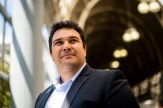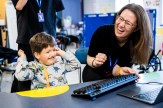NSF grant aims to enhance career opportunities for engineering students with disabilities

Individuals with disabilities have been called the “original lifehackers” because of their ability to adapt to and redesign the world around them to meet their needs.
A Northeastern University professor has received a grant from the National Science Foundation to help such lifehackers enter the civil engineering industry.
“That ‘lifehacker’ mindset alone is really well aligned with the engineering mindset and what we want out of new, innovative engineers — the ability to see beyond what’s in front of them and be problem solvers,” says Andrew Gillen, assistant teaching professor in Northeastern’s College of Engineering.
“There’s a lot of reasons — beyond that it’s a good thing to do — as to why a company would want to bring on folks with disabilities.”
Gillen says that it is hard to say how many students in civil engineering have disabilities, as many do not disclose such information. But a 2019 study found only 6% of students across all engineering majors identified as having a disability, Gillen says.
And individuals with disabilities are underrepresented in STEM fields. About 3% of employed scientists and engineers have a disability, according to the NSF. Meanwhile, people with disabilities make up almost 29% of the total U.S. population. Moreover, engineers with disabilities are less likely to be employed than non-disabled engineers, and those who are employed generally experience lower pay than non-disabled peers.
Gillen also says there are few pathways from school into the civil engineering industry specifically designed for students with disabilities.
As a result, “industry is missing out on real talent,” Gillen says.
Featured Posts
So, Gillen and colleagues Logan Perry from University of Nebraska and Cassandra McCall at Utah State University want to figure out how to facilitate the employment of more students with disabilities in the civil engineering industry — for the benefit of both students and the civil engineering field — and create school-to-workplace partnerships.
Gillen says Northeastern is a logical collaborator for the one-year planning grant.
First, he notes that with the co-op program, the university already has established many industry connections, including in the civil engineering industry. In addition, the global network enables such industry partnerships worldwide.
Finally, he cited momentum in the College of Engineering around the issue of disability in engineering, with a neurodiversity initiative.
“There is growing momentum that emphasizes taking a strength-based approach and thinking about what strengths neurodiversity can bring to a team at a company,” Gillen says.
The grant will enable work in three phases.
The first is a review of the literature around students with disabilities in civil engineering and initiating contact with industry — both public, like departments of transportation, and private companies — within the researchers’ respective regions.
By the middle of the year, the researchers will meet with industry leaders to understand the challenges and opportunities to facilitate bringing in more civil engineering students with disabilities.
The third phase will be to synthesize the information, connect with other scholars and plan the next stages.
“The hope is that this planning grant sets the baseline for a much bigger project where we’re facilitating these partnerships at scale,” Gillen says. “The end goal of this planning would be to have a bigger project with the stage fully set — partners secured and a proposal under review.”
“Embracing the unique perspectives and skills of students with disabilities isn’t just about filling positions,” Gillen says. “It’s essential for driving innovation in civil engineering.”










